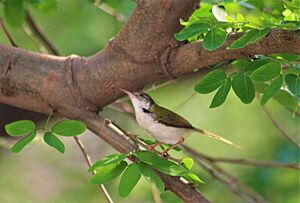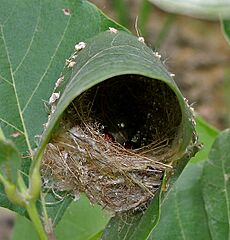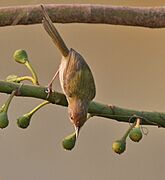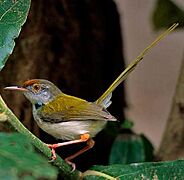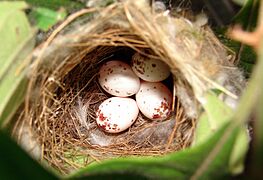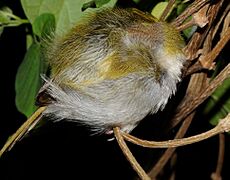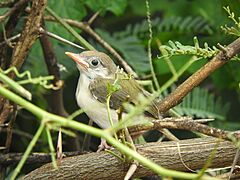Common tailorbird facts for kids
Quick facts for kids Common tailorbird |
|
|---|---|
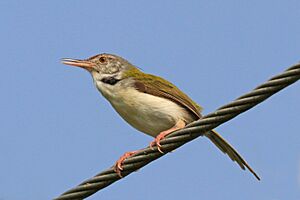 |
|
| Male | |
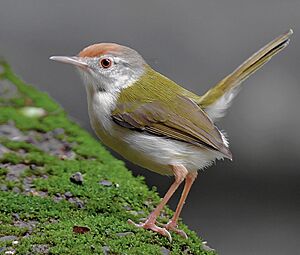 |
|
| Female
|
|
| Conservation status | |
| Scientific classification | |
| Genus: |
Orthotomus
|
| Species: |
sutorius
|
| Subspecies | |
|
|
The common tailorbird (Orthotomus sutorius) is a small songbird that lives across tropical Asia. It's famous for its amazing nest, which looks like leaves "sewn" together. You might know it as Darzee from Rudyard Kipling's Jungle Book stories! These birds are often found in gardens, even though they can be shy and hide in plants. You'll usually hear their loud calls before you see them. Tailorbirds have a long tail that often points upwards. They have green feathers on their upper body and a rusty-colored forehead. This type of bird is usually found in open fields, bushy areas, forest edges, and gardens.
Tailorbirds get their name from how they build their nests. They poke holes in the edges of a large leaf and then "sew" them together. They use plant fibers or spider silk for this. This creates a little cradle where they build their actual nest.
Contents
About the Tailorbird's Name
The scientific name for the tailorbird is Orthotomus sutorius. The word sutorius means "cobbler," which is someone who makes or fixes shoes. The word Orthotomus means "straight-cutting."
Scientists used to group this bird with other birds in the family Sylviidae. But newer studies show it belongs to the Cisticolidae family. This family also includes birds like Prinia and Cisticola.
There are many different types, or subspecies, of the common tailorbird. They live in different parts of Asia. For example, some live in Sri Lanka, others in India, and some in Southeast Asia.
What Tailorbirds Look Like
The common tailorbird is a colorful bird. It has bright green feathers on its back and creamy white feathers underneath. These birds are usually about 10 to 14 centimeters (4 to 5.5 inches) long. They weigh about 6 to 10 grams (0.2 to 0.35 ounces).
They have short, rounded wings and a long tail. Their legs are strong, and they have a sharp beak. The tip of their upper beak is curved. Their tail often sticks up and moves around. The top of their head is a reddish-brown color. Both male and female tailorbirds look very similar. However, males might have longer central tail feathers during the breeding season. Young tailorbirds are not as brightly colored. When they call, you might see dark patches on the sides of their neck. These are just bare skin areas that look dark.
How Tailorbirds Live
Like most warblers, common tailorbirds eat insects. Their song is a loud cheeup-cheeup-cheeup. They often repeat these two-part calls. Tailorbirds are usually found alone or in pairs. They stay low in bushes or trees, but sometimes hop on the ground. They search for insects like beetles and bugs. They are often drawn to flowers because insects gather there. They also visit flowers like mango and Bombax for nectar. Sometimes, they get covered in pollen, making their heads look golden.
During times when they are not breeding, these birds sleep alone. But during the breeding season, they might sleep side-by-side. Sometimes, a young bird that has just learned to fly will sleep between the adult birds. They choose thin branches on trees that have good cover above them. They often roost near human homes and lights.
Building a Nest
Tailorbirds breed mostly from March to December in India. The busiest time is from June to August, which is the wet season. In Sri Lanka, they breed mainly from March to May and August to September. However, they can breed all year round.
The tailorbird's nest is a deep cup. It is lined with soft materials. The nest is placed inside thick leaves that have been "sewn" together. The outside of the leaves faces outwards, which helps hide the nest. The holes they make in the leaves are tiny. This means the leaves don't turn brown, which helps keep the nest hidden.
Scientists have studied how tailorbirds build their nests. They don't actually tie knots. Instead, they pierce two leaves and pull a fiber through them. The fibers fluff out on the outside, acting like little rivets or fasteners. Sometimes, the nest is made from just one large leaf. The edges of this leaf are fastened together. There are many different ways tailorbirds build their nests. Some nests might not even have the leaf cradle.
The female tailorbird usually lays three eggs. The eggs hatch in about 12 days. Both the male and female tailorbirds help feed the young birds. Sadly, many eggs and chicks don't survive. This is because of predators like rodents, cats, and lizards. The young birds are ready to leave the nest in about 14 days. Some say only the female sits on the eggs, while others say both parents do. However, both parents definitely help feed and clean the nest. Males are also said to feed the female while she is sitting on the eggs. Sometimes, other birds, like the Plaintive Cuckoo, lay their eggs in a tailorbird's nest.
Tailorbirds in Stories

The famous story "Rikki-Tikki-Tavi" is one of Rudyard Kipling's Jungle Book tales. It features a tailorbird couple named Darzee and his wife. Darzee means "tailor" in Urdu. In the story, Darzee's wife pretends to be hurt to distract enemies. However, real tailorbirds don't actually do this.
There is also a classic book of children's folk tales in Bengali called "Tuntunir Boi." This book is named after the local name for the tailorbird, tuntuni.
Images for kids



